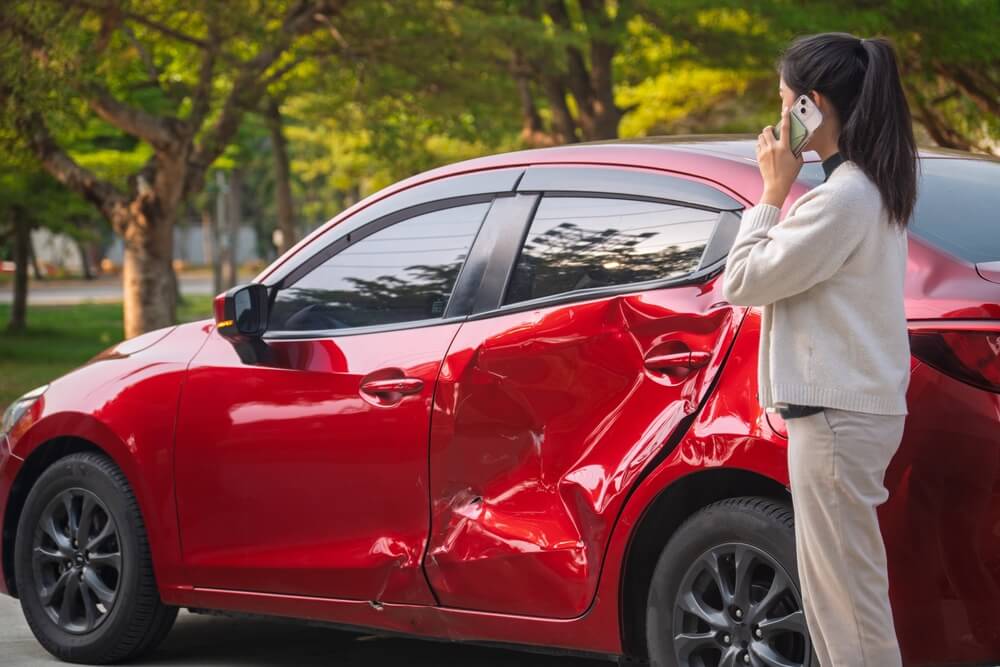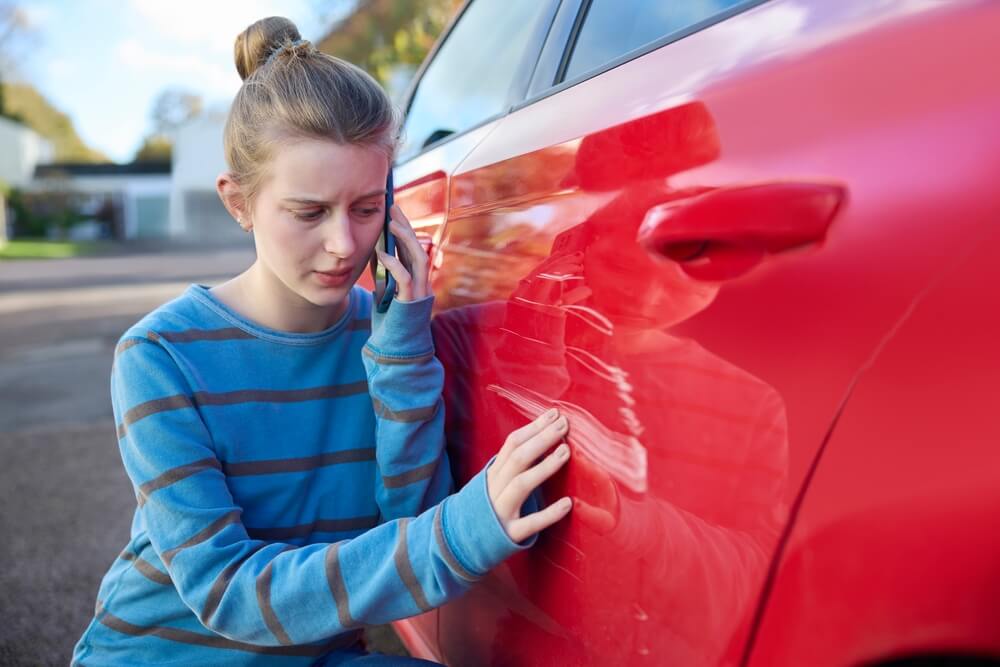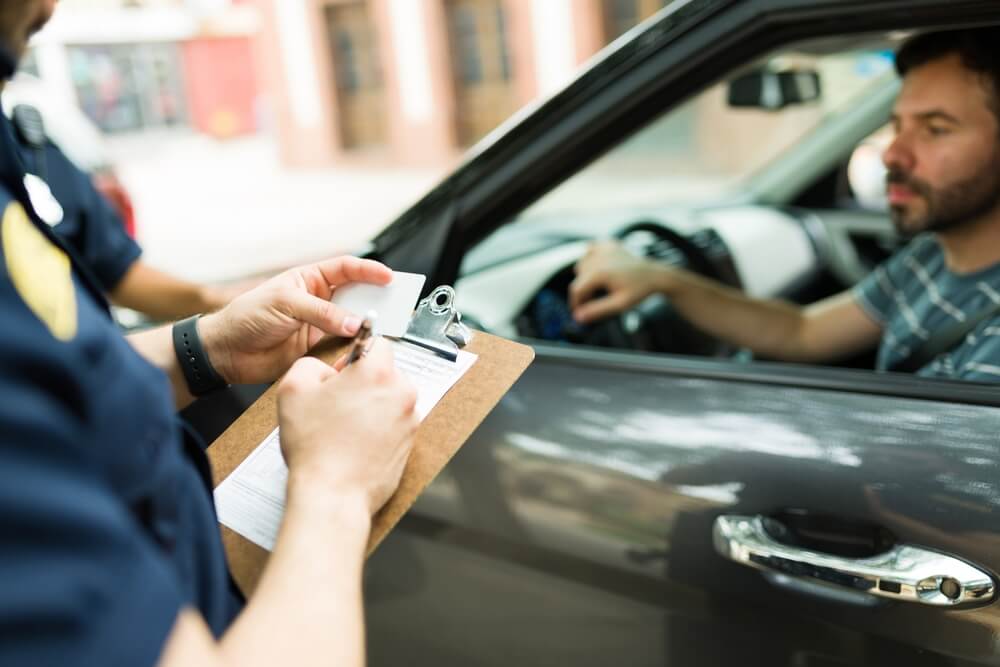
If you are not redirected within 30 seconds, please click here to continue.
Samedi: 10h – 16h HAE

If you are not redirected within 30 seconds, please click here to continue.
If you are not redirected within 30 seconds, please click here to continue.
56% of Canadians admit to road rage, 81% say they've witnessed it
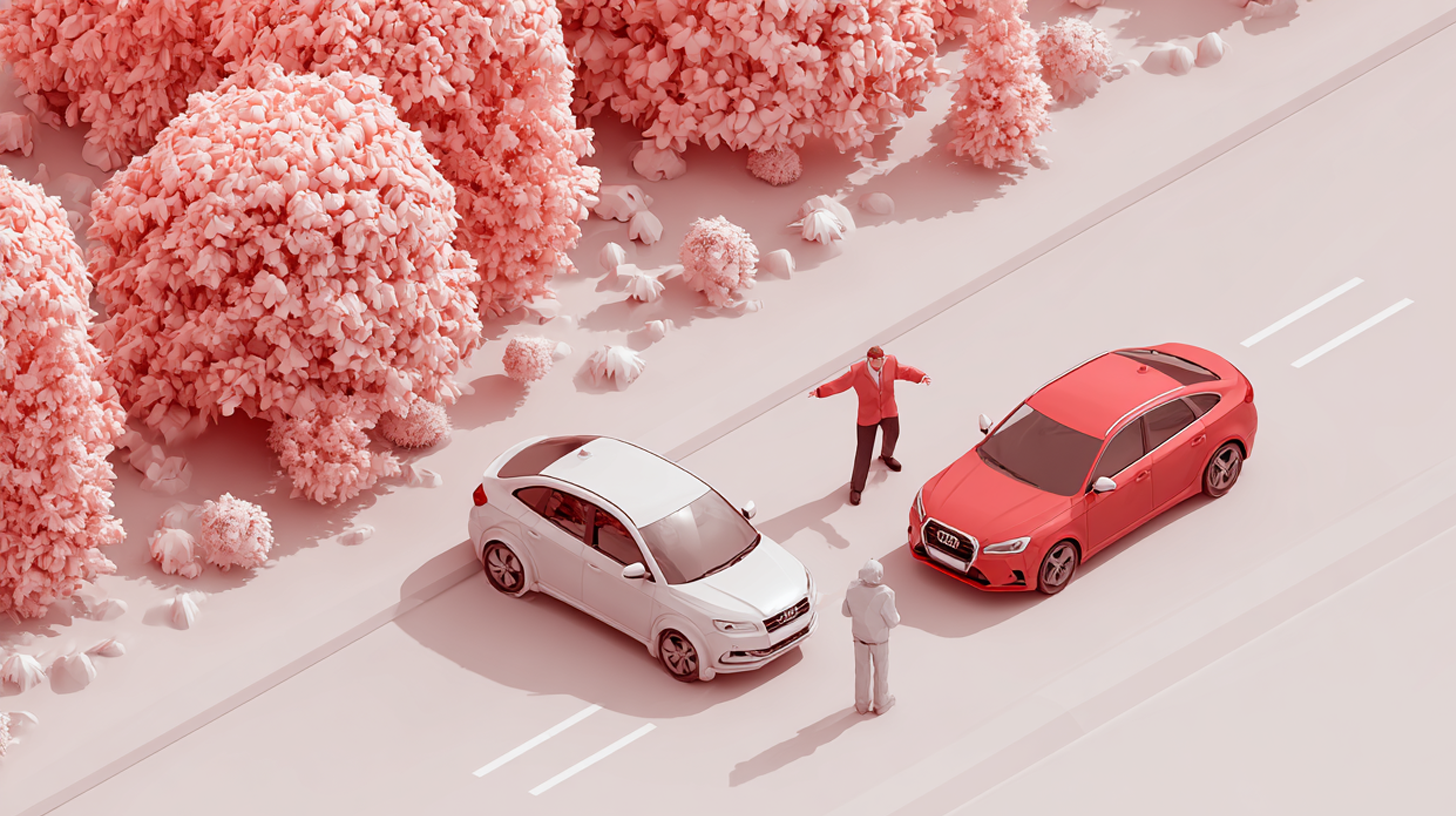
Table of Contents
KEY FINDINGS
- 56% of Canadians admit to engaging in road rage behaviors, while 81% report witnessing such incidents
- Drivers under 55 are more likely to engage in road rage, with 63% admitting to such behaviors compared to 47% of those aged 55 and older. Younger drivers also witness more incidents (83% vs. 78%).
- Urban drivers experience higher rates of aggressive behaviors, including honking (52%), tailgating (57%), and cutting off others (58%), largely due to congestion and time pressures.
- Aggressive driving can have financial consequences, with minor convictions increasing insurance premiums by up to 30%.
Ever find yourself in this position? You’re cut off in traffic, someone lays on the horn, and before you know it, things get heated. It might be a shouted insult, a rude gesture or worse.
Road rage is a common occurrence across Canada, often escalating from gestures and shouting to dangerous confrontations. It can take many forms from verbal threats to physical violence.
Julie Christiansen, a registered psychotherapist in Ontario and author of The Rise of Rage, explains that road rage is fueled by the same anger we see in everyday life, but with a dangerous twist. “When people are in control of a 1,500-pound weapon and they don’t know how to regulate that emotion, their car becomes a tool to act out their aggression,” she says.
Recent data backs this up. According to a 2025 survey by Leger for Rates.ca, 56% of Canadians reported engaging in at least one road rage-related behavior—unchanged from 2024—while 81% said they had witnessed such behavior, a slight decrease from 83% the previous year.
What are the most common road rage behaviors?
According to the survey, the following is the list of the most common forms of road rage, and how many respondents have either been involved in or observed each:
- Honking: Engaged (38%) vs. Observed (52%)
- Flashing lights: Engaged (21%) vs. Observed (43%)
- Tailgating: Engaged (16%) vs. Observed (57%)
- Obscene gesturing (e.g., giving the finger): Engaged (15%) vs. Observed (41%)
- Brake-checking or tapping brakes: Engaged (14%) vs. Observed (38%)
- Cutting off another driver: Engaged (14%) vs. Observed (58%)
- Vehicle collision: Engaged (9%) vs. Observed (34%)
- Rolling down the window to yell at someone: Engaged (8%) vs. Observed (35%)
- Stopping and exiting the vehicle to confront someone: Engaged (3%) vs. Observed (20%)
There are signs that people are keeping cooler in 2025 than in previous years, however. For example, fewer drivers reported being cut off—down from 63% in 2024 to 58% this year. Observed tailgating also dropped from 61% to 57%. Honking went down from 57% to 52%, flashing headlights from 48% to 43%, and rude gestures like giving the finger from 45% to 41%.
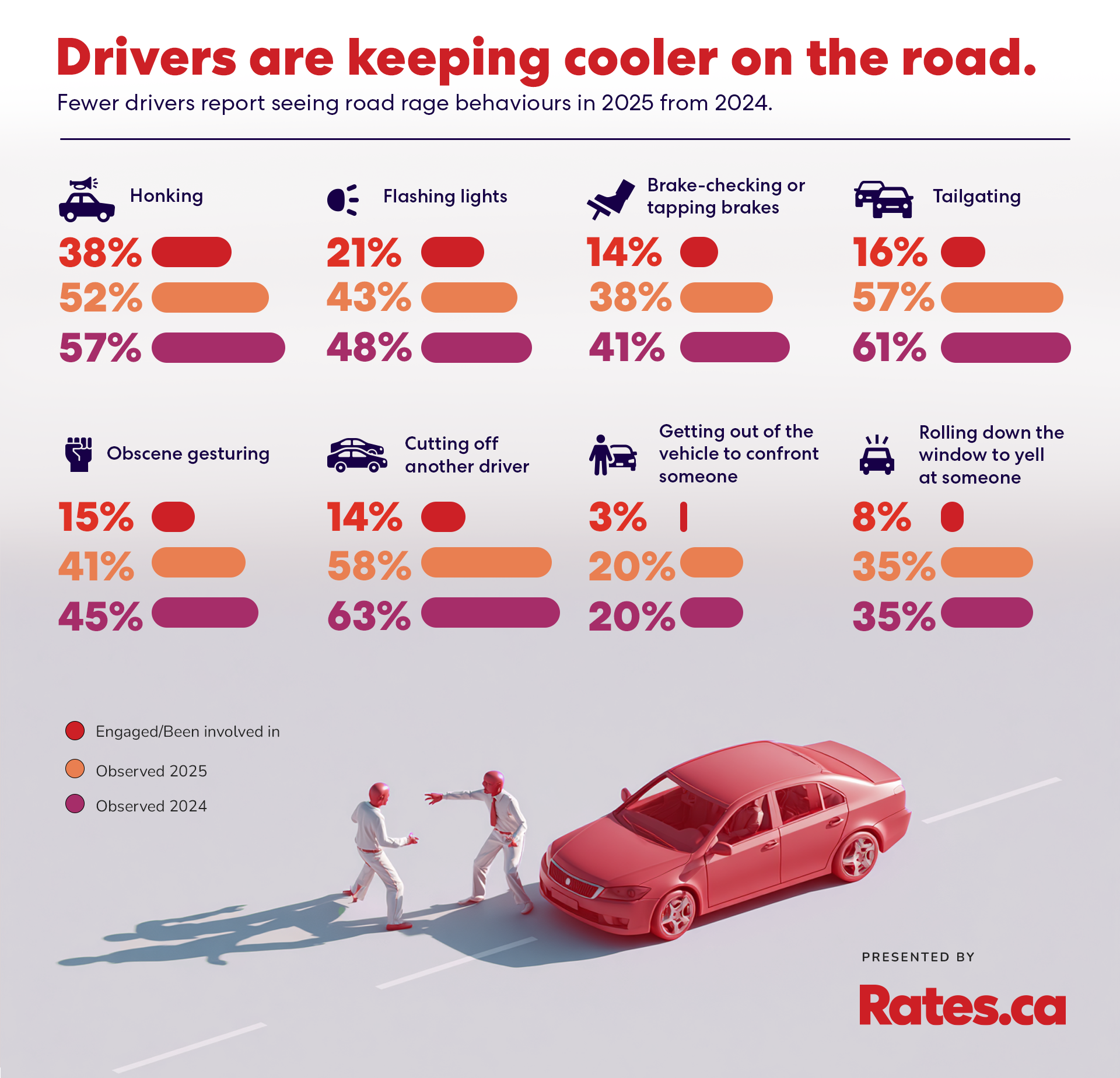
Daniel Ivans, an insurance expert at Rates.ca, says that while these behaviors may seem minor, they can escalate quickly and lead to serious consequences.
“Aggressive driving behaviors like tailgating or brake-checking can result in collisions or charges, which not only put people at risk but also affect their insurance premiums,” he notes.
Read more: The roads are heating up: 83% of drivers witnessed road rage, only 56% admit to engaging in it
Drivers under 55 are still more likely to engage in road rage
The survey shows that drivers under 55 were significantly more likely to engage in road rage behaviors, with 63% reporting engagement compared to 47% of those aged 55 and older. Similarly, younger drivers were more likely to observe road rage incidents, with 83% witnessing such behaviors in the past year, compared to 78% of drivers aged 55 and older.
“The younger part of that demographic (especially those under 25), their brains haven’t fully developed yet, so they don’t have complete impulse control like someone who may be in the 35 to 55 age group might have,” explains Christiansen.
She adds that groupthink — a psychological phenomenon where individuals in a group are more likely to conform to the dominant attitude or behavior, even if it’s risky or irrational — can also play a role.
“When you’ve got a young person, they’ve got their buddies in the car and they’re like, ‘Oh, that guy just cut you off — go get him,’ you have this mentality that fuels it,” she says.
This doesn’t mean an older demographic is immune to road rage behavior.
“People underestimate the tenacity of men in that 55 to 65 age group,” she says. “You see a guy with white hair and assume he’s tame—but that’s not always the case.”
Christiansen suggests that broader generational and social changes may help explain road rage trends across age groups.
“We’re more digitally connected now, but less emotionally connected. That disconnect can make it easier to lash out — like the other person doesn’t matter,” she says.
This emotional distance, combined with stress, entitlement, or a sense of anonymity behind the wheel, may be contributing to the aggression, even among drivers who may be considered less likely to react.
Read next: Requirements and restrictions for getting your G1 in Ontario
Rush hour congestion is fueling road rage behaviours
Road rage behaviors often flare up when drivers are under pressure and what kind of environment they are in.
Overall, 81% of drivers say they’ve witnessed aggressive driving. However, urban drivers were more likely to observe these behaviors, such as honking (52%), tailgating (57%), and cutting off others (58%), according to the report.
“It does seem to be when people are commuting,” says Craig Worden, president of market research firm Pollara Strategic Insights, which regularly polls Canadians on their rage levels. He points to the stress of congestion and tight schedules in cities like triggers for road rage.
A 2025 analysis by the UK-based rate comparison siteMoneySuperMarket ranked Canada second in the world for average long-distance driving speed, with drivers averaging 108 km/h (67.1 mph) between major cities.
According to the analysis, which used data from the Google Routes API, rural highways ranked at the top for consistent, efficient travel, thanks to low congestion and well-maintained infrastructure. These smoother conditions outside urban centers support steady driving, not widespread speeding.
This contrast helps explain why our survey finds that rural drivers, who face less time pressure, report fewer aggressive behaviors. In cities, delays and dense traffic create more stress and more chances for conflict behind the wheel.
There are also regional differences in how drivers express that frustration. In Quebec drivers report more flashing headlights (30%), while drivers in the rest of Canada more often report obscene gestures (17%), brake-checking (15%), yelling from vehicles (9%), and collisions (10%).
Road rage remains a serious concern on Canadian roads, often triggered by aggressive driving behaviors.
“Aggressive driving is the action, and road rage is the emotion,” explains Worden.
“The number one thing that will cause people to get angry when they're driving is when others don’t stop at a red light or a stop sign,” he says. “Close behind that, we’re finding it’s also people who don’t signal when they make a turn.”
Is the temperature dropping on Canadian rage?
Our collective road rage doesn’t just stem from other people’s bad driving. Christiansen believes it reflects something deeper.
“Society has for generations told people they’re not allowed to feel or express anger,” she says.
Add to that the stress of modern life — political and economic tensions, and divisive rhetoric — and it’s no surprise some people might be struggling to keep their cool.
“We have so much that we’re frustrated with and don’t feel like we have control over, so we have no choice now but to find an outlet,” she explains. Road rage is a result of how people handle anger and stress. “We don’t have anger problems; we have problems that make us angry.”
That broader emotional landscape may help explain why Canadians’ overall frustration levels appear to be cooling or at least shifting direction. According to the June edition of Rage Index from Pollara Strategic Insights, Canadians aren’t feel as enraged as before. Overall, the Rage Index has declined by 8 points—from 54% in November 2024 to 46% in June.
The index also found that frustration with the federal government has tapered off somewhat since November, with a similar decline in anger toward provincial governments. Worden attributes this shift to a more hopeful political climate following the recent federal election.
Public sentiment appears to support that view: just over a third of Canadians reported feeling positive about the election outcome, while slightly fewer expressed negative feelings.
Has Canadian rage found a new target?
According to the report, 78% of Canadians say they feel angry when thinking about U.S. President Donald Trump.
“Donald Trump remains a lightning rod for anger in Canada, and as a consequence, our governments and politicians are seen in a more positive light, which has brought down the overall temperature in Canada,” says Worden.
However, he cautions that this drop in political anger may be short-lived.
“It really is driven by current events,” he says. “What happens in the economy, politics, and people’s personal finances will determine whether this trend continues.”
Money, in fact, remains a consistent source of frustration. Pollara’s Rage Index shows that over half of Canadians are still angry about the state of the economy, and 38% are dissatisfied with their personal financial situation.
“It’s nice to see the Rage Index come down,” Worden adds, “but we’re still seeing people quite unhappy with the economy and their personal finances.”
Read next: Ask the Expert: How Trump's tariffs will affect your Canadian mortgage
Why does road rage happen?
According to Christiansen, road rage is a mix of emotional, psychological, and situational pressures. She identifies four common triggers that often spark anger while driving:
- Breaking the rules: For example, when someone runs a red light.
- Crossing personal boundaries: Like when another driver cuts you off or swerves into your lane.
- Blocked goals: Such as being stuck in traffic when you're already late.
- Feeling unsafe: When another driver’s actions make you fear for your safety.
These triggers rarely occur in isolation. More often, Christiansen notes, they pile up—creating a perfect storm for rage on the road.
How road rage can affect your car insurance rates
Another reason why people often lean into anger? They simply don’t realize that there are real-world consequences of road rage.
“You shouldn’t practice those behaviors because if you’re observed doing any of those things by law enforcement, you’re probably going to get pulled over,” says Ivans. “That could result in higher insurance premiums, court dates—really, all kinds of trouble.”
When it comes to auto insurance, your driving record plays a major role in determining your premiums and even minor traffic convictions can have a significant impact.
Minor convictions include:
- Failing to signal
- Failing to yield
- Following too closely
- Improper lane change or passing
- Speeding (under 50 km/h over the limit)
- Unsafe maneuvers
These infractions are often associated with aggressive driving. As Ivans explains:
“Typically, people that commonly exhibit these sorts of behaviors on the road are going to be more likely to be involved in car crashes or have multiple convictions on their record.”
To better understand how minor driving convictions affect insurance costs, we ran a series of quotes using Rates.ca for a 35-year-old male driver in Toronto, insuring a one-year-old Honda Civic. Here’s what we found:
- With no convictions, the lowest available premium was $263.67 per month, or $3,164 annually.
- After adding one minor conviction, the premium jumped to $316.25 monthly ($3,795 annually), marking a 20% increase.
- With two convictions, the rate rose further to $341.25 per month, or $4,095 annually—an overall increase of nearly 30% from the original quote.
These figures show how costly even minor infractions can be when it comes to auto insurance. If road rage leads to an accident, insurers may strip you of safe driver discounts.
To help mitigate these risks, many insurers offer telematics programs that reward safe driving habits by tracking behaviors like hard braking, rapid acceleration, and nighttime driving.
“If you do have a telematics device in your vehicle and you're doing a lot of heavy braking events, it won’t be used to increase your premiums,” Ivans says. “You just won't get the discount that's associated with the telematics device.”
Other insurers offer savings for safe driving, with performance tracked through apps like Desjardins’ Ajusto, which provides an initial 10% discount just for signing up, and offers an additional 10% to 25% off for drivers who achieve a score of 76 or higher
Ultimately, the best way to save money on insurance is simply to drive safely and avoid lashing out on the road. Maintaining a clean record—free of traffic violations and at-fault collisions—remains one of the most effective ways to prevent premium hikes.
That starts with understanding your triggers and practicing self-control.
“Engagement leads to escalation,” says Christiansen. “If someone approaches your vehicle, you don’t have to engage. Keep your windows up, press the OnStar button, call 911—let someone know what’s happening. And if you’re being followed, don’t go home—drive straight to a police station.”
Ultimately, Christiansen believes road rage comes down to how people respond when they’re pushed to their limits.
Read more: What can void your car insurance in Ontario?
Methodology
Leger is the largest Canadian-owned full-service market research firm. An online survey of 1,519 Canadians was completed between June 27 and June 30, 2025, using Leger’s online panel. Leger's online panel has approximately 400,000 members nationally and has a retention rate of 90 per cent. A probability sample of the same size would yield a margin of error of ±2.5% (19 times out of 20).
Don't waste time calling around for auto insurance
Use RATESDOTCA to shop around, and compare multiple quotes at the same time.
Get money-saving tips in your inbox.
Stay on top of personal finance tips from our money experts!


